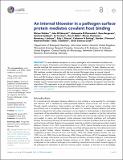Files in this item
An internal thioester in a pathogen surface protein mediates covalent host binding
Item metadata
| dc.contributor.author | Walden, Miriam | |
| dc.contributor.author | Edwards, John Michael | |
| dc.contributor.author | Dziewulska, Aleksandra Malgorzata | |
| dc.contributor.author | Bergmann, Rene | |
| dc.contributor.author | Saalbach, Gerhard | |
| dc.contributor.author | Kan, Su-Yin | |
| dc.contributor.author | Miller, Ona Kealoha | |
| dc.contributor.author | Weckener, Miriam | |
| dc.contributor.author | Jackson, Rosemary J. | |
| dc.contributor.author | Shirran, Sally Lorna | |
| dc.contributor.author | Botting, Catherine Helen | |
| dc.contributor.author | Florence, Gordon John | |
| dc.contributor.author | Rohde, Manfred | |
| dc.contributor.author | Banfield, Mark J. | |
| dc.contributor.author | Schwarz-Linek, Uli | |
| dc.date.accessioned | 2015-06-02T12:10:04Z | |
| dc.date.available | 2015-06-02T12:10:04Z | |
| dc.date.issued | 2015-06-02 | |
| dc.identifier | 187656154 | |
| dc.identifier | 6d9be525-5339-4fa7-8e7a-d7353e3d7cb1 | |
| dc.identifier | 84933047743 | |
| dc.identifier | 000374253400001 | |
| dc.identifier.citation | Walden , M , Edwards , J M , Dziewulska , A M , Bergmann , R , Saalbach , G , Kan , S-Y , Miller , O K , Weckener , M , Jackson , R J , Shirran , S L , Botting , C H , Florence , G J , Rohde , M , Banfield , M J & Schwarz-Linek , U 2015 , ' An internal thioester in a pathogen surface protein mediates covalent host binding ' , eLife , vol. 4 , e06638 . https://doi.org/10.7554/eLife.06638 | en |
| dc.identifier.issn | 2050-084X | |
| dc.identifier.other | ORCID: /0000-0003-3516-3507/work/32169110 | |
| dc.identifier.other | ORCID: /0000-0003-0526-223X/work/40714971 | |
| dc.identifier.other | ORCID: /0000-0001-9921-4399/work/56638870 | |
| dc.identifier.uri | https://hdl.handle.net/10023/6727 | |
| dc.description | This work was supported by the MRC, UK grant MR/K001485 for MW, JME, MR, MJB, USL; the BBSRC, UK grant BB/J00453 and the John Innes Foundation for MJB; the Wellcome Trust Institutional Strategic Support Fund 097831/Z/11/B for AMD; Wellcome Trust/JIF award 063597 and Wellcome Trust grants WT079272AIA and 094476/Z/10/Z to CHB for the BSRC Mass Spectrometry and Proteomics Facility; University of St Andrews and School of Biology for SYK; The Carnegie Trust for OKM. | en |
| dc.description.abstract | To cause disease and persist in a host, pathogenic and commensal microbes must adhere to tissues. Colonization and infection depend on specific molecular interactions at the host-microbe interface that involve microbial surface proteins, or adhesins. To date, adhesins are only known to bind to host receptors non-covalently. Here we show that the streptococcal surface protein SfbI mediates covalent interaction with the host protein fibrinogen using an unusual internal thioester bond as a ‘chemical harpoon’. This cross-linking reaction allows bacterial attachment to fibrin and SfbI binding to human cells in a model of inflammation. Thioester-containing domains are unexpectedly prevalent in Gram-positive bacteria, including many clinically relevant pathogens. Our findings support bacterial-encoded covalent binding as a new molecular principle in host-microbe interactions. This represents an as yet unexploited target to treat bacterial infection and may also offer novel opportunities for engineering beneficial interactions. | |
| dc.format.extent | 24 | |
| dc.format.extent | 4266149 | |
| dc.language.iso | eng | |
| dc.relation.ispartof | eLife | en |
| dc.subject | Streptococcus pyogenes | en |
| dc.subject | Streptococcus pneumoniae | en |
| dc.subject | Clostridium perfringens | en |
| dc.subject | Host-microbe interactions | en |
| dc.subject | Fibrinogen | en |
| dc.subject | Bacterial surface proteins | en |
| dc.subject | QH301 Biology | en |
| dc.subject | QR Microbiology | en |
| dc.subject | DAS | en |
| dc.subject | BDC | en |
| dc.subject | R2C | en |
| dc.subject | SDG 3 - Good Health and Well-being | en |
| dc.subject.lcc | QH301 | en |
| dc.subject.lcc | QR | en |
| dc.title | An internal thioester in a pathogen surface protein mediates covalent host binding | en |
| dc.type | Journal article | en |
| dc.contributor.sponsor | Medical Research Council | en |
| dc.contributor.sponsor | The Wellcome Trust | en |
| dc.contributor.institution | University of St Andrews. School of Biology | en |
| dc.contributor.institution | University of St Andrews. School of Chemistry | en |
| dc.contributor.institution | University of St Andrews. EaSTCHEM | en |
| dc.contributor.institution | University of St Andrews. Biomedical Sciences Research Complex | en |
| dc.identifier.doi | https://doi.org/10.7554/eLife.06638 | |
| dc.description.status | Peer reviewed | en |
| dc.identifier.grantnumber | MR/K001485/1 | en |
| dc.identifier.grantnumber | 094476/Z/10/Z | en |
This item appears in the following Collection(s)
Items in the St Andrews Research Repository are protected by copyright, with all rights reserved, unless otherwise indicated.

